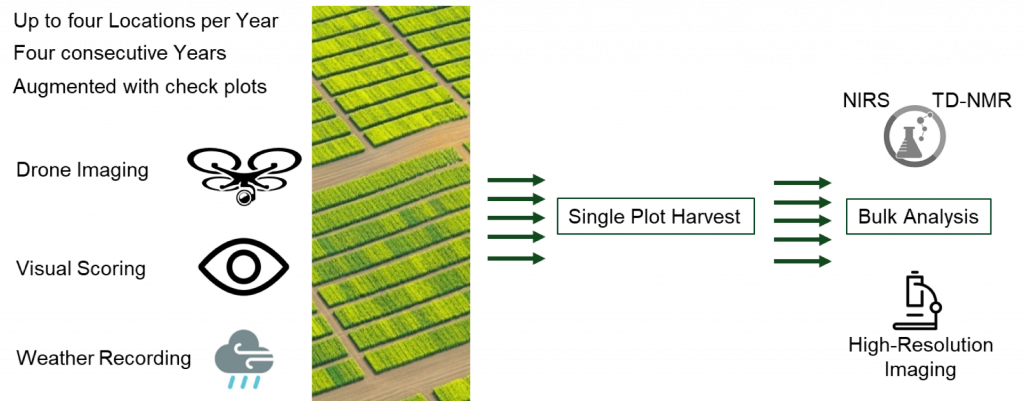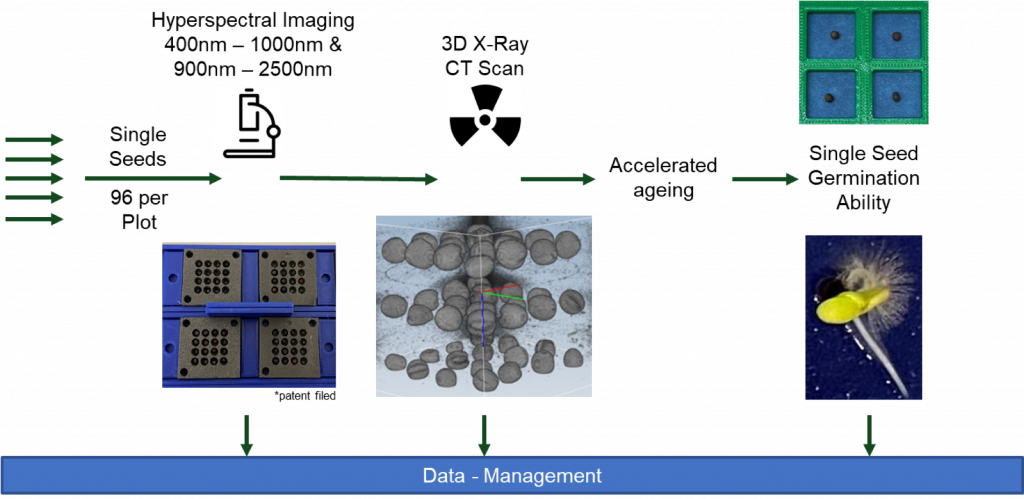Project leader: Dr. Amine Abadi (NPZ Innovation GmbH)
Email:Co-Project leader: Matthias Enders (NPZ Innovation GmbH)
Staff:
- Simon Goertz
- Jennifer Zur
- Mareike Léon
- Milka Malenica
- Eric Oldenburg
- Dirk Stulgies
A large and diverse set of 400 rapeseed lines, provided by NPZ Innovation GmbH (NPZi), derived from applied breeding programs and augmented with additional genotypes of high scientific relevance, is planted in dedicated field trails in four consecutive years in up to four locations per year. High density genotypic information was generated using the 15k-Brassica SNP Chip and completed by dense phenotypic data on multiple traits accessed in the field. The breeder’s visual scoring in the field was accompanied by a drone-based assessment using RGB and multispectral sensors. To complete the assessment mobile weather stations and soil sensors were installed to record environmental effects influencing plant and seed properties. After harvesting and cleaning, a comprehensive and deep phenotyping of seeds is conducted. This includes bulk tests to access thousand kernel mass, geometric properties of the seeds as well as the quantification of specific bio-chemical compounds using near-infrared spectroscopy (NIRS) and time domain nuclear magnetic resonance (TD-NMR).

Further explorative approaches are non-destructive imaging technologies like hyperspectral imaging, covering the range of 400nm to 2500nm with a recording of up to 550 single wavelengths. Furthermore, the internal structure of the seeds is uncovered using a computed tomography (CT) scan. To account for the higher seed quality and germination ability in elite breeding material an accelerated ageing assay is applied to the seeds in accordance with International Seed Testing Association (ISTA) rules. This artificial stress application is capable of simulating seed response to long term storage and emphasize slight differences in seed quality and germination ability. Finally, all single seeds will be scored visually for germination ability in three classes (normal seedlings, abnormal seedlings, non-germinated seeds). High throughput analysis methods in AVATARS are tied up with a highly automated data registration and management system. To synchronize the data between the project partners, a data exchange protocol has been established that is based on the “Digital Twin” concept.

All datasets will be analyzed using complementary techniques to maximize the possible insights into the biological process of germination in exchange with other activities in AVATARS as well as the scientific and industrial impact. Therefore, classical biostatistical and image analysis techniques will be applied by NPZi as well as IPK. This classical approach will be taken to the next level using novel deep learning methods, developed by the University of Kaiserslautern, capable of learning underlying models to predict single seed germination. Finally, innovative 3D visualizations in virtual reality (VR) will be developed by Breakpoint One to make the dataset accessible for human inspection with a special emphasis on the strength of humans to find patterns and anomalies visually.